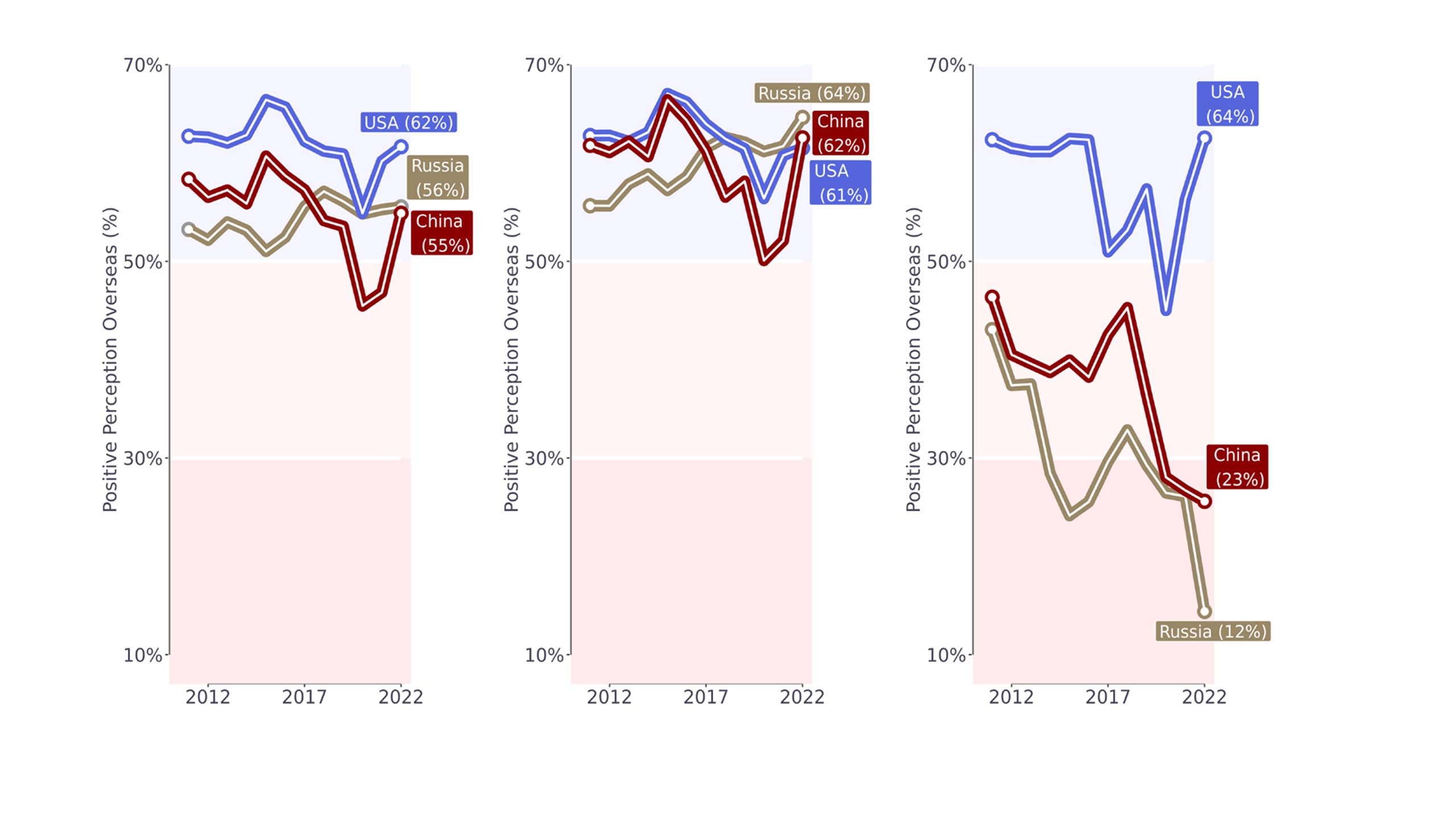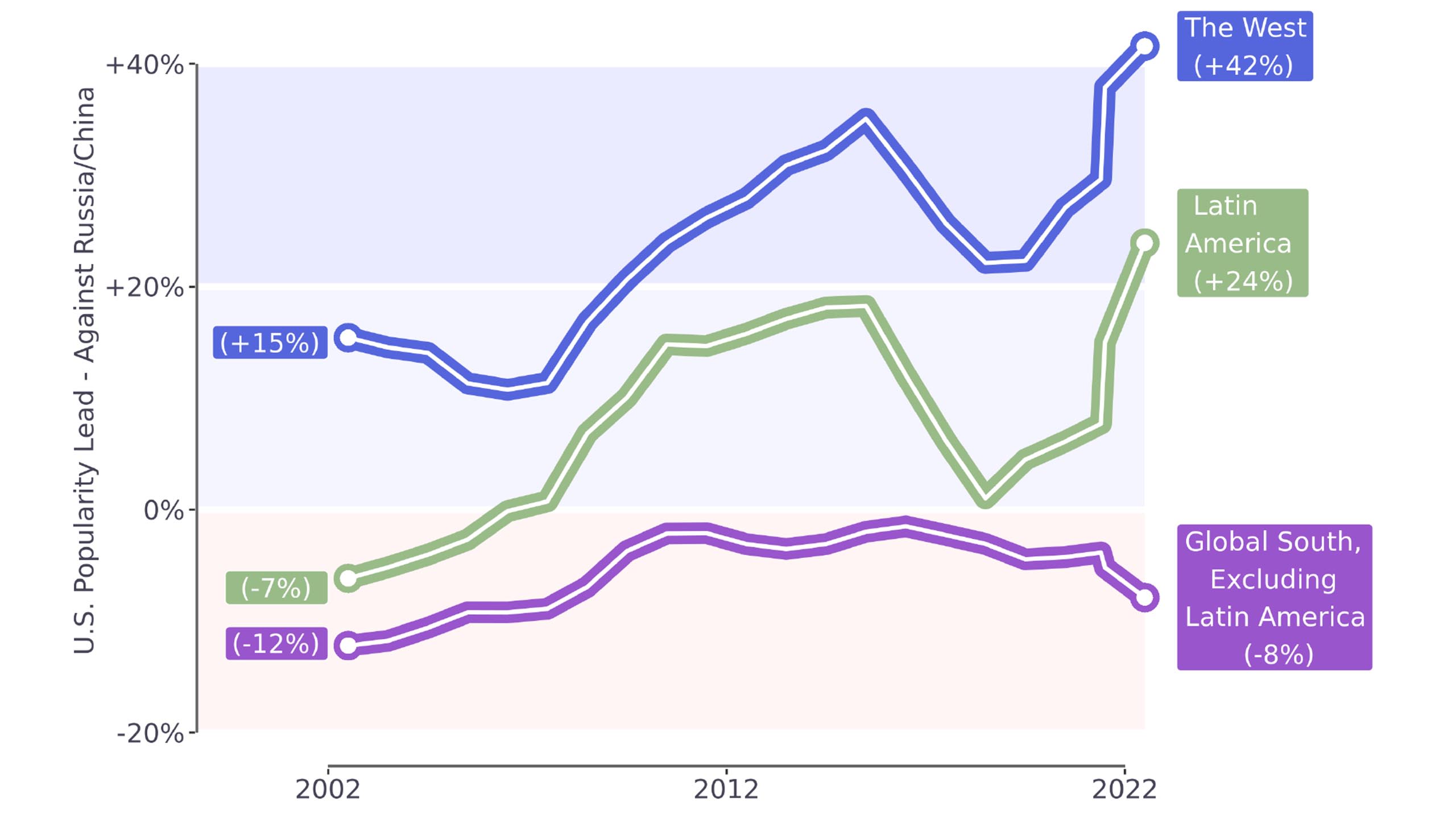风萧萧_Frank
以文会友乌克兰战争扩大了全球公众对美国、中国和俄罗斯态度的分歧
https://www.cam.ac.uk/stories/worlddivided
弗雷德·卢西
“世界已分为自由领域和非自由领域”
在世界各地,公众对国际政治的态度正在凝聚成两个对立的阵营:支持美国的自由民主国家和支持中国和俄罗斯的威权国家公民 — — 乌克兰战争加速了这一进程。
这是剑桥大学研究人员的说法,他们“统一”了在 137 个国家(其中包括自 2022 年 2 月俄罗斯袭击乌克兰以来的 75 个国家)进行的调查数据,发现了一种鸿沟(持续了十年),导致全球人口两极分化。
他们说,俄罗斯的战争让西方人民对美国和北约更加忠诚,并使拉丁美洲和东欧的富裕民主国家采取了亲美立场。
然而,报告也指出了一个不自由和不民主社会的区域,从东亚穿过中东一直延伸到西非,其特点是完全相反的趋势:近年来,人们对中国、俄罗斯或两者的支持稳步增加。 年。
根据该大学未来中心今天发布的报告,在世界自由民主国家的 12 亿人口中,四分之三 (75%) 的人对中国持负面看法,87% 的人对俄罗斯持负面看法 民主(CFD)。
然而,在世界上其余136个国家的63亿人口中,情况恰恰相反——70%的人对中国持积极态度,66%的人对俄罗斯持积极态度。
该分析包括来自新兴经济体和全球南方国家的重要民意数据,并表明这种分歧不仅是经济或战略上的,而且基于个人和政治意识形态。
报告合著者、剑桥贝内特公共政策研究所的泽维尔·罗梅罗-维达尔博士表示:“世界已分为自由领域和非自由领域。”
“今天的全球鸿沟并不那么依赖于国家之间的历史联系。 我们发现,衡量世界各地社会地缘政治协调程度的最有力指标是其基本价值观,例如言论自由。”
海事与欧亚集团
新鸿沟的一侧是研究人员所说的“海洋联盟”,其原则基于贸易和思想自由流动以及保护个人权利。
这些国家包括欧洲大部分地区以及美洲和澳大利亚更稳定的地区。 尽管受到特朗普总统任期的干扰,他们的北极星仍然主要是美国。
对立的集群以中国和俄罗斯为核心的“欧亚集团”为中心,横跨欧亚大陆与中亚、伊朗和阿拉伯中东以及非洲和东南亚的大部分地区都有联系。
研究人员表示,与冷战时代的一些比较仍然成立,因为后一个群体广泛团结在拒绝“西方现代性”和自由主义价值观上。
剑桥贝内特研究所 CFD 联席主任、合著者罗伯托·福阿 (Roberto Foa) 博士表示:“高收入民主国家已经变得更加世俗化,更愿意接受少数群体的权利,但世界其他地区却没有。”
“像普京这样的独裁者利用这个机会将自己描绘成他们所谓的‘传统’价值观的捍卫者,以应对西方自由主义的威胁。”
对乌克兰的战争“加剧”了这种分歧,但调查结果表明,这种分歧已经酝酿了十年,因为十年前,全球公众对地缘政治的看法更加复杂和不确定。
研究人员认为,中国的自信和跨国基础设施投资以及中国和俄罗斯对非洲的战略重点都有助于改变局面。
福阿说:“俄罗斯的战争导致全球分歧加剧,现在划定的战线反映了自由主义和威权主义的两面。”
“如果我们观察世界各地不同人群对俄罗斯的看法,我们会发现他们的政府在外交上对待俄罗斯的方式几乎是相同的。”
“民主和言论自由是混乱的,即使是最成熟的民主国家近年来也证明了这一点”
罗伯托·福阿博士
过去十年全球舆论对俄罗斯、中国和美国的趋势。 在全球范围内,美国仍然领先于中国和俄罗斯。 然而,这掩盖了发达国家和发展中国家之间的重大分歧。 在其他西方国家,美国的相对好感度已飙升至新高,尽管俄罗斯和中国在南半球国家中已经超越。
“民主和言论自由是混乱的,即使是最成熟的民主国家近年来也证明了这一点”
罗伯托·福阿博士
过去十年全球舆论对俄罗斯、中国和美国的趋势。 在全球范围内,美国仍然领先于中国和俄罗斯。 然而,这掩盖了发达国家和发展中国家之间的重大分歧。 在其他西方国家,美国的相对好感度已飙升至新高,尽管俄罗斯和中国在南半球国家中已经超越。
中国、俄罗斯和美国——全球态度数据
报告发现,十年来俄罗斯一直在失去西方极端分子的“边缘”支持。 截至 2022 年入侵乌克兰前夕,对俄罗斯持积极看法的西方公民比例已从五分之二 (39%) 降至不到四分之一 (23%),目前仅为八分之一( 12%)。
与此同时,希腊(69%至30%)、匈牙利(45%至25%)或意大利(38%至14%)等以前同情俄罗斯的欧洲国家的公众对俄罗斯的积极性大幅下降。
然而,在发展中国家地区,俄罗斯仍然受到青睐。 其中 75% 的受访者来自南亚,68% 的受访者来自非洲法语区,62% 的受访者来自东南亚。
事实上,尽管发生了 2022 年的入侵,巴基斯坦、沙特阿拉伯和马来西亚以及印度和越南对俄罗斯的公众舆论仍然持积极态度。
同样,现在西方对中国的态度也与其他国家产生了分歧。 就在五年前,五分之二(42%)的西方公民对中国持积极看法,这一数字几乎减少了一半(23%)。
然而,在经历了新冠疫情造成的下滑之后,中国在发展中国家的受欢迎程度有所回升,尤其是在参与庞大“一带一路”倡议的147个国家的46亿人中,其中近三分之二的人对中国持积极看法 ,而非参与国家只有四分之一 (27%)。
拉丁美洲似乎是一个主要的例外,与其他发展中国家地区相比,该地区的受访者现在对美国的支持度比中国高出创纪录的 24%。
虽然南半球大部分地区在美国和中国或俄罗斯之间保持中立,但拉丁美洲是一个主要例外 — — 人们对该地区北方邻国的相对积极情绪达到历史新高。
对民主的不满
新的断层线很大程度上源于对民主的态度。 “民主社会对俄罗斯和中国的态度要消极得多,而对于更专制的社会则相反。 这种关联在十年前并不存在,但在今天却非常明显,”罗梅罗-维达尔说。
然而,一些选举民主国家对俄罗斯和中国高度积极。 这些国家都在与腐败和民主合法性作斗争,例如印度尼西亚、印度和尼日利亚。
事实上,在大多数人对俄罗斯持好感的国家中,有 69% 的人对民主表示不满。 此外,在所有对民主不满占多数的国家中,四分之三(73%)的公众对中国也持积极态度。
“人们认为的民主缺陷与公众对俄罗斯和中国的接受度提高有关。 民主和言论自由是混乱的,即使是最成熟的民主国家近年来也证明了这一点,”福阿补充道。
“中国提供了一种专制现代化的模式,在这种模式中,为了经济增长和国家威望的承诺而放弃个人自由。
“中国与美国的相对吸引力可能不仅仅是美国作为盟友的吸引力问题,而是作为政治模式的问题。”
War in Ukraine has widened a global divide in public attitudes toward US, China and Russia
https://www.cam.ac.uk/stories/worlddivided
By Fred Lewsey
“The world has divided into liberal and illiberal spheres”
Around the world, public attitudes toward international politics are coalescing into two opposing blocks: liberal democracies favouring the United States and citizens of more authoritarian nations who back China and Russia – a process accelerated by the war in Ukraine.
This is according to University of Cambridge researchers, who “harmonised” data from surveys conducted in 137 countries, including in 75 countries since Russia attacked Ukraine in February 2022, and found a divide – growing for a decade – that now polarises the global population.
They say that Russia’s war has led people in the West to feel ever greater allegiance to both the US and NATO, and brought wealthier democracies in Latin America and Eastern Europe towards a pro-American stance.
However the report also identifies a zone of illiberal and undemocratic societies, stretching from East Asia through the Middle East and out towards West Africa, characterised by the exact opposite trend: populations that have steadily increased support for China, Russia, or both, in recent years.
Among the 1.2 billion people who inhabit the world’s liberal democracies, three-quarters (75%) now hold a negative view of China, and 87% a negative view of Russia, according to the report, published today by the University’s Centre for the Future of Democracy (CFD).
Yet among the 6.3 billion who live in the world’s remaining 136 countries, the opposite is the case – with 70% of people feeling positively towards China and 66% towards Russia.
The analysis includes significant public opinion data from emerging economies and the Global South, and suggests this divide is not just economic or strategic but based in personal and political ideology.
“The world has divided into liberal and illiberal spheres,” said report co-author Dr Xavier Romero-Vidal, from Cambridge’s Bennett Institute for Public Policy.
“Today’s global divide does not depend as much on historic ties between nations. The strongest indicators we found for how societies across the world align geopolitically are their fundamental values, such as freedom of expression.”
Maritime vs Eurasian Bloc
On one side of the new divide are what researchers call the “maritime alliance”, with principles based in free flows of trade and ideas, and the protection of individual rights.
These countries include much of Europe and more stable parts of the Americas and Australasia. Their lodestar is still primarily the US, despite the disturbance of the Trump presidency.
The opposing cluster is centred on a “Eurasian Bloc” anchored by China and Russia, with links across the continent to Central Asia, Iran and the Arab Middle East, as well as large parts of Africa and Southeast Asia.
Researchers say that some comparisons to the Cold War era still hold, as this latter group is broadly united in a rejection of “western modernity” and liberal values.
“High-income democracies have become steadily more secular and receptive to minority rights, but the rest of the world has not,” said co-author Dr Roberto Foa, co-director of the CFD at Cambridge’s Bennett Institute.
“Autocrats such as Putin have taken the opportunity to present themselves as defenders of what they call ‘traditional’ values against a perceived threat of western liberalism.”
The war on Ukraine has “galvanised” this divide, but the findings suggest it has been a decade in the making, as global public opinion on geopolitics was far more mixed and undefined ten years ago.
The researchers argue that China’s assertiveness and transnational infrastructure investments have helped shift the dial, as well as both China and Russia’s strategic focus on Africa.
“Russia’s war has caused this global divide to intensify, as literal battle lines are now drawn that reflect the two sides of liberal freedoms and authoritarianism,” said Foa.
“If we look at how different populations around the world feel towards Russia, we find an almost identical reflection of how their governments have handled the country diplomatically.”
"Democracy and free expression are messy, as even the most established democracies have demonstrated in recent years"
Dr Roberto Foa

Trends in global public opinion towards Russia, China and the United States over the course of the past decade. Globally, the United States has retained its popularity lead over China and Russia. However, this masks a major divergence between developed and developing countries. In fellow western countries, America’s relative favourability has soared to newfound highs, though Russia and China have overtaken in the Global South.
China, Russia and the US – global attitude data
The report finds that Russia has been losing its “fringe” support among extremists in the West for a decade. The proportion of western citizens with a positive view of Russia had already fallen from two in five (39%) to less than a quarter (23%) by the eve of the 2022 invasion of Ukraine, and now stands at just one in eight (12%).
Meanwhile, public positivity toward Russia has plummeted in formerly sympathetic European countries such as Greece (69% to 30%), Hungary (45% to 25%) or Italy (38% to 14%).
In developing country regions, however, Russia is still viewed favourably. This includes 75% of respondents in South Asia, 68% in Francophone Africa, and 62% in Southeast Asia.
In fact, despite the 2022 invasion, public opinion of Russia remains positive in Pakistan, Saudi Arabia and Malaysia, as well as both India and Vietnam.
Similarly, attitudes to China now split the West from the rest. Just five years ago, two in five (42%) western citizens held a positive view of China, a figure that has almost halved (23%).
However, after a Covid-related dip, China’s popularity in the developing world has rebounded, especially among the 4.6 billion people in 147 countries participating in the colossal “Belt and Road Initiative” – among whom almost two-thirds hold a positive view of China, compared to just a quarter (27%) in non-participating countries.
The one major exception appears to be Latin America, where – in contrast to other developing country regions – respondents now favour the United States over China by a record 24% point lead.

While much of the global south remains neutral between the United States and China or Russia, Latin America stands out as the major exception – with relative positive feelings towards the region’s northern neighbour reaching record highs.
Dissatisfaction with democracy
Much of the new fault line is rooted in attitudes towards democracy. “Democratic societies are far more negative towards Russia and China, whereas the reverse is true for more authoritarian societies. This association did not exist a decade ago, yet is quite clear today,” said Romero-Vidal.
However, a number of electoral democracies are highly positive about Russia and China. These are nations struggling with corruption and democratic legitimacy, such as Indonesia, India and Nigeria.
In fact, dissatisfaction with democracy is a majority view in 69% of the countries in which most people feel favourably toward Russia. Moreover, out of all nations in which dissatisfaction with democracy is a majority view, three-quarters (73%) also have publics who are positive about China.
“Perceived democratic shortcomings are associated with greater public receptivity towards Russia and China. Democracy and free expression are messy, as even the most established democracies have demonstrated in recent years,” added Foa.
“China offers a model of authoritarian modernisation in which personal liberties are forsaken for the promise of economic growth and national prestige.
“The relative appeal of China versus the United States may not simply be a question of America’s attractiveness as an ally, but as a political model.”




